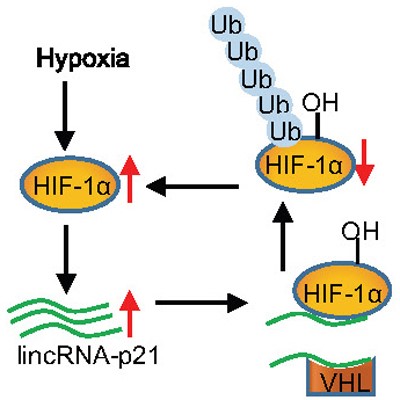Recently, the research group led by
Prof. WU Mian and Prof. MEI Yide at Hefei National Laboratory for Physical Sciences at Microscale (HFNL) and School of Life Sciences, USTC has revealed a novel mechanism whereby lincRNA-p21 regulates the Warburg effect under hypoxic conditions. The paper entitled "Reciprocal regulation of HIF-1α and lincRNA-p21 modulates the Warburg effect" has been published online on the renowned international journal Molecular Cell (Molecular Cell doi:10.1016/j.molcel.2013.11.004).
It has been recognized for a long time that the metabolism of cancer cells is significantly different from that of their normal cell counterparts. Cancer cells exhibit a unique metabolism referred to as the Warburg effect (proposed by the Nobel laureate Otto Warburg in 1928), which is characterized by enhanced glycolysis and reduced oxidative phosphorylation even in the presence of oxygen. It has been well demonstrated that hypoxia contributes to the Warburg effect, yet the underlying mechanism remains largely unknown. More specifically, it has not been characterized whether long non-coding RNA (lncRNA) is involved in the regulation of the Warburg effect under hypoxic conditions.
In this study, they reported that one hypoxia/HIF-1α inducible lncRNA, lincRNA-p21, is able to interact with HIF-1α and VHL and thus disrupts the VHL-HIF-1α association. This disassociation attenuates VHL-mediated HIF-1α ubiquitination and degradation, thus forming a positive feedback loop to enhance the Warburg effect under hypoxic conditions. By using a mouse model, they also confirmed that hypoxia-induced lincRNA-p21 expression indeed promotes tumorigenesis. These data for the first time demonstrate that lincRNA-p21 is an important regulator of the Warburg effect, and also implicate lincRNA-p21 as a valuable therapeutic target for cancer.
The first author is Dr. YANG Fan from Prof. Wu’s lab. This work was financially supported by National Natural Science Foundation of China, Chinese Academic of Sciences and Ministry of Science and Technology of China.

(Hefei National Laboratory for Physical Sciences at the Microscale)